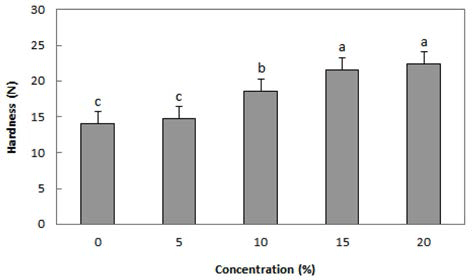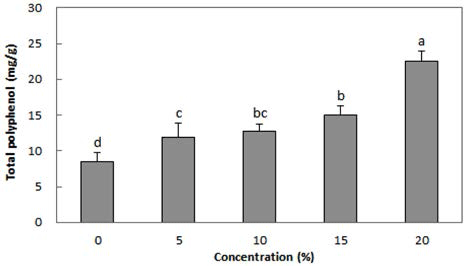INTRODUCTION
Pomegranate (Punica granatum L.) is commercially important fruits that extensively grows in may tropical and subtropical regions of the world (Tehranifar et al., 2010), but only last ten years research and commercial interests on its composition and biological properties have received the attention (Rinaldi et al., 2013). A few number of studies has been conducted in making tofu with pomegranate juice (Kim & Pakr, 2006), seockryu-pyun with pomegranate juice and concentrate (Ko et al., 2008), Korean wheat wet noodles with pomegranate cortex powder (Park et al., 2009), and jelly with pomegranate powder (PP) (Cho & Choi, 2009).
Pomegranate has provided exceptional and unique sensory and nutritional properties, and consumption of fresh arils or juices has increased (Varela-Santos et al., 2012). The arils contains high amount of polyphenols, polysaccharides, sugars, and vitamins (Al-Maiman & Ahmad, 2002), and pomegranate juice is considered as a healthy food, due to its antioxidant properties, contributing to the prevention of cardiovascular diseases and cancers (Lansky & Newman, 2007; Sartippour et al., 2008; Basu & Penugonda, 2009). Other health beneficial effects of pomegranate juice consumption includes: reduction in blood pressure (Aviram et al., 2004), anti-HIV-1 activity (Neurath et al., 2005), inhibition of prostrate cancer in men (Pantuck et al., 2006), a reduced atherosclerosis in diabetic patients (Rock et al., 2008), and potential protection against colon cancer (Kasimsetty et al., 2010).
Identification of ways, especially the concentration to incorporate pomegranate fruit as a health food ingredient in human diet is necessary before we can successfully use the fruit as a value-added food component. However, there is limited information on the potential for incorporation of pomegranate powder in bakery products such as cookies and its contribution to sensory characteristics and consumer acceptance of the final product. Therefore, the objectives of this research were to evaluate the impact on baking on the physicochemical properties and consumer liking of cookies incorporated with different levels of PP and to provide suitable consumer experimental data in developing new types of valueadded or functional foods.
Materials and Methods
Pomegranate powder (Garunara, Seoul, Korea), soft wheat flour (CJ Corp., Seoul, Korea), granulated sugar (CJ Corp., Incheon, Korea), butter (Seoul Milk Co-op., Yongin, Gyeonggi, Korea), salt (Daesang Corp., Seoul, Korea), and eggs were procured from a local market and kept at 25 °C before use.
Ingredients were mixed in a Kitchen Aid mixer (model 5K5SS, Whirlpool Corp., St. Joseph, MI, USA) using a flat beater attachment as described in AACC method 10-52 (AACC, 2000) by substituting up to 20% (wt.) of PP based on the total weight of the soft wheat flour. The dough was aged for 1 h in a refrigerator at 4°C and then sheeted to a thickness of 5 mm using a rolling pin. The cookie doughs were cut with a cookie cutter to a 5 cm diameter and transferred to a lightly greased baking tray, then baked at 170°C for 12 min using a multifunctional convection oven (model GOR-704C, TongYang Magic Corp., Seoul, Korea). The baked cookies were cooled to room temperature for 1 h and packed in airtight bags before use.
The pH of each sample (homogenized with 5 g sample + 45 mL distilled water) was measured using a pH meter (pH/Ion 510, Oakton Instruments, Vernon Hills, IL, USA). Same sample was used to determine the soluble solids contents using a digital refractometer (PR-201, Atago Co., Tokyo, Japan). The moisture content, expressed in percent wet basis (% w.b.), was measured by the gravimetric method using a laboratory convection oven (WFO-700W, Tokyo Rikakikai Co., Tokyo, Japan) at 105°C for 24 h. All measurements were repeated 5 times.
Surface color at the middle of each cookie was measured with a Chromameter (model CR-200, Minolta Co., Osaka, Japan) calibrated with a white tile (Y = 94.2, x = 0.3131, and y = 0.3201). L* (lightness), a* (greenness [-] to redness [+], and b* (blueness [-] to yellowness [+]) values were recorded. All measurements were done in 5 times.
Hardness of 20 cookies was evaluated measuring the peak breaking force (N) using the three-point break (triple beam snap) technique with a computer-controlled Advanced Universal Testing System (model LRXPlus, Lloyd Instrument Ltd., Fareham, Hampshire, UK) at room temperature. The crosshead speed was 1 mm/s and span between the two platforms was 40 mm.
Total phenolics were quantified by the Folin-Denis spectrophotometric assay as previously described (Singleton et al., 1999). Briefly, 1.0 mL of filtered phenolic extract, standard or blank was mixed with 2 mL of distilled water followed by the addition of 1.0 mL of Folin-Denis reagent and 2 mL of 1 N Na2CO3. The mixture was shaken and kept in the dark for 1 h before being measured spectrophotometrically at 750 nm.
Each sample was also evaluated by 50 consumer panelists composed of university students. Five samples were presented in random order and were asked to evaluate the consumer attributes of color, flavor, taste, texture, and overall acceptability. The 9-point hedonic scale, anchored at the left as “1=extremely dislike” and at the right as “9=extremely like” was used (Peryam & Girardot, 1952). Panelists received a tray containing the samples (randomly coded using a three-digit number), a glass of water, and an evaluation sheet. Participants were advised to rinse their palates between samples and break for 30 s. Enough space was given to handle the samples and the questionnaire, and the evaluation time was not constrained.
The statistical analyses were performed using SAS version 9.2 (SAS Institute Inc., Cary, NC, USA). An analysis of variance (ANOVA) was performed using the general linear models (GLM) procedure to identify significant differences among the samples. Mean values were compared using Duncan's multiple range test at 5% level.
Results and Discussion
The cookie formula used in this study contained PP. The scope of this work was to increase the functionality of cookies by adding PP, and at the same time maintaining a good sensory quality. The amount of PP was increased from 0-20% of the wheat flour and cookies with those blends are called control, PP5, PP10, PP15, and PP20.
The effect of the PP supplementation on cookie dough characteristics, such as pH, moisture content, and soluble solids content is summarized in Table 1. pH of dough ranging from 4.33 to 6.66, decreased significantly with the addition of PP (p < 0.05). Similar significant reduction of pH was found for cookie dough prepared with shredded garlics (Kim et al., 2002), ginseng powder (Kang et al., 2009), and Saururus chinensis powder (Bae et al., 2010) as it was due to acidic nature of the powder itself.
Moisture content of the control dough was 15.15% and gradually decreased with the higher amount of PP in the formulation (p < 0.05); however, appreciable differences were not found. On the other hand, soluble solids content increased significantly from 1.96 to 3.54 as the amount of PP increased (p < 0.05) due to the fact that PP provided more soluble solids than wheat flour in the formulation.
Selected physicochemical properties of cookies are presented in Table 2. pH and moisture content decreased whilst soluble solids content of the cookies increased significantly (p < 0.05), as similar as in the dough. It is also noted that moisture content of the dough dropped sharply after the baking process. Lightness (L*) decreased significantly as the PP content increased in cookie (p < 0.05) as expected. Lightness of control decreased up to 32.3% when 20% PP was added in the formulation. Redness (a*), on the other hand, increased significantly as the amount of PP increased in cookie (p < 0.05). Similar changes in the lightness and redness were reported for cookies prepared with Pleurotus eryngii powder (Kim et al., 2010) and black rice bran (Joo & Choi, 2012). It is due to the natural color of PP and this suggested that the color of final product may be controlled by the amount of PP sample in the formulation.
Hardness is one of the common indices to determine cookie quality. The hardness increased steadily from 14.05 to 22.44 N for the control and PP20, respectively (Fig. 1). Hardness of PP15 and PP20 was significantly higher than that of other samples (p < 0.05), without significant difference between them. In addition, no significant difference between the hardness of control and PP5 was found (p > 0.05). Kim and Park (2006) also reported a similar result that the hardness of tofu coagulated with pomegranate increased significantly with the higher amount of pomegranate in the formulation (p < 0.05). Hardness of cookies is closely related to its moisture content and air cell formation (Jung & Lee, 2011), and formulation (i.e., ingredients) and mixing ratios can also be factors.

Total polyphenol content (TPC) of cookies as affected by the PP content is shown in Fig. 2. The TPC of control, PP5, PP10, PP15, and PP20 was 8.47, 11.85, 12.73, 15.06, and 22.49 mg/ g, respectively. It increased significantly with the addition of PP in general (p < 0.05) although no significant differences were found between samples PP5 and PP10, as well as PP10 and PP15 (p > 0.05). Ko et al. (2008) reported a similar increase in the antioxidant property in terms of DPPH radical scavenging activity when pomegranate juice or concentrate was added in seokryu-pyun. In cookie making, total polyphenol content also increased with increase in the level of Pleurotus eryngii powder (Kim et al., 2010) and black rice bran powder (Joo & Choi, 2012).

The 9-point hedonic scale was used to determine which levels of PP addition to cookies were accepted by the majority of consumers. Table 3 shows the mean scores of consumer acceptance results for the five attributes including color, taste, flavor, texture, and overall acceptability. In terms of color, the control, PP5, and PP10 received the comparatively favorable mean scores ranged from 5.72 to 6.26 with no significant difference (p > 0.05), followed by PP15 sample. On the other hand, PP20 received the lowest mean score of 4.60 with respect to color among all samples tested (p < 0.05).
The mean scores of flavor acceptability ranging from 4.68 to 5.52, and appeared the least affected by the PP content in the formulation since the control and up to 15% PP addition did not significantly influence the flavor scores (p > 0.05). The consumer acceptances on taste and texture were also significantly affected by the amount of PP incorporated in the sample (p < 0.05). It is noted that PP10 for taste, and PP15 which was not significantly different from PP10 for texture received significantly higher acceptance scores, respectively (p < 0.05).
With respect to overall acceptability, PP10 received the highest mean score of 6.28; however, it was not significantly different from that of PP15 (p>0.05). PP20 received the lowest mean score of 3.70, significantly lower score than those of all other samples (p<0.05). PP20 was not favored for most of the consumer panelists probably due to its stronger flavor and darker color which the consumers were not used to them. Incorporation of PP into wheat flour in cookie-making showed that supplemented cookies influenced the selected physicochemical properties, and improved the sensory attributes such as flavor, taste, texture, and overall acceptability if the concentration was appropriate. PP addition at 10% of wheat flour was found to be the optimum incorporation level for the highest consumer acceptability of the cookies.